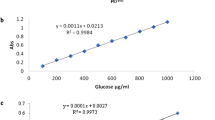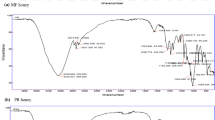Abstract
The North-Eastern region of India is known for its rich flora and has great potential for honey production. Honey samples collected from local markets of different regions of North-East India viz. Shillong, Sohra, Mawsynram, Jorhat and Tezpur were analyzed for physicochemical properties, bioactivity and mineral content. Effect of sonication time on the bioactive properties of honey was determined. All the honey samples had good bioactive properties and high content of potassium, sodium, calcium and iron. The Jorhat sample had the highest phenolic content (296.68 ± 2.16 mg GAE/100 g) and flavonoid content (155.26 ± 2.90 μg quercetin/100 g) whereas highest DPPH radical scavenging activity with an IC50 value of 29.8 ± 0.20 g and a FRAP value of 7291.60 ± 584.6 μM Fe(II)/100 g were noted in Shillong sample. Sonication exhibited various effects on the bioactive properties of the selected honey samples based on their source and treatment time. Honey from Jorhat and Sohra exhibited good quality standards with HMF content less than 80 mg/kg.


Similar content being viewed by others
References
Aghamirlou HM, Khadem M, Rahmani A, Sadeghian M, Mahvi AH, Akbarzadeh A, Nazmara S (2015) Heavy metals determination in honey samples using inductively coupled plasma-optical emission spectrometry. J Environ Health Sci Eng 13:39. https://doi.org/10.1186/s40201-015-0189-8
Ajlouni S, Sujirapinyokul P (2010) Hydroxymethylfurfuraldehyde and amylase contents in Australian honey. Food Chem 119(3):1000–1005
Altemimi A, Watson DG, Choudhary R, Dasari MR, Lightfoot DA (2016) Ultrasound assisted extraction of phenolic compounds from peaches and pumpkins. PLoS ONE 11(2):e0148758. https://doi.org/10.1371/journal.pone.0148758
Anklam E (1998) A review of the analytical methods to determine the geographical and botanical origin of honey. Food Chem 63(4):549–562
Annegowda H, Anwar L, Mordi M, Ramanathan S, Mansor S (2010) Influence of sonication on the phenolic content and antioxidant activity of Terminalia catappa L. leaves. Pharmacogn Res 2(6):368–373
AOAC (2005) Official methods of analysis. In: Association of official analytical chemists, 18th, edn. AOAC, Washington, DC
Bertoncelj J, Dobersek U, Jamnik M, Golob T (2007) Evaluation of the phenolic content, antioxidant activity and colour of Slovenian honey. Food Chem 105(2):822–828
Biesaga M, Pyrzynska K (2013) Stability of bioactive polyphenols from honey during different extraction methods. Food Chem 136(1):46–54
Boussaid A, Chouaibi M, Rezig L, Hellal R, Donsì F, Ferrari G, Hamdi S (2014) Physicochemical and bioactive properties of six honey samples from various floral origins from Tunisia. Arab J Chem 11(2):265–274
Bradford MM (1976) A rapid and sensitive method for the quantitation of microgram quantities of protein utilizing the principle of protein-dye binding. Anal Biochem 72(1–2):248–254
Can Z, Yildiz O, Sahin H, Turumtay AE, Silici S, Kolayli S (2015) An investigation of Turkish honeys: their physico-chemical properties, antioxidant capacities and phenolic profiles. Food Chem 180(1):133–141
Crane E (1990) Bees and beekeeping: science, practice and world resources. Heinemann Newness, London, pp 388–451
Carrera C, Ruiz-Rodríguez A, Palma M, Barroso CG (2012) Ultrasound assisted extraction of phenolic compounds from grapes. Anal Chim Acta 732:100–104
Chang CC, Yang MH, Wen HM, Chern JC (2002) Estimation of total flavonoid content in propolis by two complementary colorimetric methods. J Food Drug Anal 10(3):178–182
Codex Alimentarius Commission “Revised Codex Standard for Honey Codex Stan 12-1981, Rev. 1 (1987), Rev. 2 (2001),” Codex Standard, vol 12. 1981, pp 1-7. https://teca.fao.org/sites/default/files/resources/Annex%20A%20Codex%20Alimentarius%20Honey%20Standard.pdf. Accessed 10 June 2017
Ding J, Wang X, Zhang T, Li Q, Luo M (2006) Optimization of RP-HPLC analysis of low molecular weight organic acids in soil. J Liq Chromatogr Relat Technol 29(1):99–111
Dobre I, Georgescu LA, Alexe P, Escuredo O, Seijo MC (2012) Rheological behavior of different honey types from Romania. Food Res Int 49:126–132
Elhamirad AH, Zamanipoor MH (2012) Thermal stability of some flavonoids and phenolic acids in sheep tallow olein. Eur J Lipid Sci Technol. https://doi.org/10.1002/ejlt.201100240
El-Haskoury R, Kriaa W, Lyoussi B, Makni M (2018) Ceratonia siliqua honeys from Morocco: physicochemical properties, mineral contents, and antioxidant activities. J Food Drug Anal 26:67–73
Erdtman G (1960) The acetolysis method in a revised description. Svensk Bot Tid-skrift Lund 54:561–564
Esmaeili KA, Mat Taha R, Mohajer S, Banisalam B (2015) Antioxidant activity and total phenolic and flavonoid content of various solvent extracts from in vivo and in vitro grown Trifolium pratense L. (Red Clover). Biomed Res Int 2015:1–11
Froschle M, Horn H, Spring O (2018) Characterization of Jatropha curcas honeys originating from the southern highlands of Madagascar. LWT Food Sci Technol 93:525–533
Janghu S, Bera MB, Nanda V, Rawson A (2017) Study on power ultrasound optimization and its comparison with conventional thermal processing for treatment of raw honey. Food Technol Biotechnol 55(4):570–579
Jasicka-Misiak I, Poliwoda A, Dereń M, Kafarski P (2012) Phenolic compounds and abscisic acid as potential markers for the floral origin of two Polish unifloral honeys. Food Chem 131(4):1149–1156
Kabbani D, Sepulcre F, Wedekind J (2011) Ultrasound-assisted liquefaction of rosemary honey: influence on rheology and crystal content. J Food Eng 107(2):173–178
Kayacier A, Karaman S (2008) Rheological and some physicochemical characteristics of selected Turkish honeys. J Texture Stud 39(1):17–27
Küçük M, Kolayli S, Karaoğlu Ş, Ulusoy E, Baltaci C, Candan F (2007) Biological activities and chemical composition of three honeys of different types from Anatolia. Food Chem 100(2):526–534
Lira AQ, Santos AA, Alvarez GA, Munguia AR, Buendia IA, Montiel RGC (2017) Effects of liquefying crystallized honey by ultrasound on crystal size, 5-hydroxymethylfurfural, colour, phenolic compounds and antioxidant activity. Eur Food Res Technol 243(4):619–626
Louveaux J, Maurizio A, Vorwohl G (1970) Methods of Melissopalynology. Bee World 51:125–138
Majid I, Nayik GA, Nanda V (2015) Ultrasonication and food technology: a review. Cogent Food Agric 1(1):1071022
Naczk M, Shahidi F (2004) Extraction and analysis of phenolics in food. J Chromatogr A 1054(1–2):95–111
Nadeem M, Ubaid N, Qureshi TM, Munir M, Mehmood A (2018) Effect of ultrasound and chemical treatment on total phenol, flavonoids and antioxidant properties on carrot-grape juice blend during storage. Ultrason Sonochem 45:1–6
Nanda V, Sarkar BC, Sharma HK, Bawa AS (2003) Physico-chemical properties and estimation of mineral content in honey produced from different plants in Northern India. J Food Compos Anal 16(5):613–619
Paniwnyk L, Beaufoy E, Lorimer JP, Mason TJ (2001) The extraction of rutin from flower buds of Sophora japonica. Ultrason Sonochem 8(3):299–301
Perezarquillue C, Conchello P, Arino A, Juan T, Herrera A (1994) Quality evaluation of Spanish rosemary (Rosmarinus officinalis) honey. Food Chem 51(2):207–210
Pohl P, Stecka H, Sergiel I, Jamroz P (2012) Different aspects of the elemental analysis of honey by flame atomic absorption and emission spectrometry: a review. Food Anal Methods 5(4):737–751
Robak J, Kisiel W, Wolbi M (1991) Ultrasound-induced oxidation of flavonoids. Polish J Pharmacol Pharm 43(2):145–152
Saikia S, Mahanta CL (2013) Effect of steaming, boiling and microwave cooking on the total phenolics, flavonoids and antioxidant properties of different vegetables of Assam, India. Int J Food Nutr Sci 2:47–53
Saikia S, Mahnot NK, Mahanta CL (2015) Optimisation of phenolic extraction from Averrhoa carambola pomace by response surface methodology and its microencapsulation by spray and freeze drying. Food Chem 171(1):144–152
Saikia S, Mahnot NK, Mahanta CL (2016) A comparative study on the effect of conventional thermal pasteurisation, microwave and ultrasound treatments on the antioxidant activity of five fruit juices. Food Sci Technol Int 22(4):288–301
Saxena S, Gautam S, Sharma A (2010) Physical, biochemical and antioxidant properties of some Indian honeys. Food Chem 118(2):391–397
Silici S, Sagdic O, Ekici L (2010) Total phenolic content, antiradical, antioxidant and antimicrobial activities of Rhododendron honeys. Food Chem 121(1):238–243
Singh N, Bath PK (1997) Quality evaluation of different types of Indian Honey. Food Chem 58(1–2):129–133
Singh I, Singh S (2018) Honey moisture reduction and its quality. J Food Sci Technol 55(10):3861–3871
Suárez-Luque S, Mato I, Huidobro JF, Simal-Lozano J, Sancho MT (2002) Rapid determination of minority organic acids in honey by high-performance liquid chromatography. J Chromatogr A 955(2):207–214
Taormina PJ, Niemira BA, Beuchat LR (2001) Inhibitory activity of honey against foodborne pathogens as influenced by the presence of hydrogen peroxide and level of antioxidant power. Int J Food Microbiol 69(3):217–225
Tiwari BK, OʼDonnell CP, Patras A, Cullen PJ, (2008) Anthocyanin and Ascorbic Acid Degradation in Sonicated Strawberry Juice. J Agric Food Chem 56(21):10071–10077
Turkmen M, Sari F, Poyrazoglu SE, Velioglu YS (2006) Effects of prolonged heating on antioxidant activity and colour of honey. Food Chem 95(4):653–657
Turhan I, Tetik N, Karhan M, Gurel F, Tavukcuoglu HR (2008) Quality of honeys influenced by thermal treatment. LWT Food Sci Technol 41(8):1396–1399
Zappalà M, Fallico B, Arena E, Verzera A (2005) Methods for the determination of HMF in honey: a comparison. Food Control 16(3):273–277
Zhao Y, Hou Y, Tang G, Cai E, Liu S, Yang H, Zhang L, Wang S (2014) Optimization of ultrasonic extraction of phenolic compounds from Epimedium brevicornum maxim using response surface methodology and evaluation of its antioxidant activities in vitro. J Anal Methods Chem. https://doi.org/10.1155/2014/864654
Acknowledgements
NKM is thankful to Department of Science and Technology, Ministry of Science and Technology, New Delhi for Grant of fellowship (DST/INSPIRE Fellowship/2013/482).
Author information
Authors and Affiliations
Corresponding author
Ethics declarations
Conflict of interest
We declare that there is no conflict of interest.
Electronic supplementary material
Below is the link to the electronic supplementary material.
Rights and permissions
About this article
Cite this article
Mahnot, N.K., Saikia, S. & Mahanta, C.L. Quality characterization and effect of sonication time on bioactive properties of honey from North East India. J Food Sci Technol 56, 724–736 (2019). https://doi.org/10.1007/s13197-018-3531-1
Revised:
Accepted:
Published:
Issue Date:
DOI: https://doi.org/10.1007/s13197-018-3531-1




